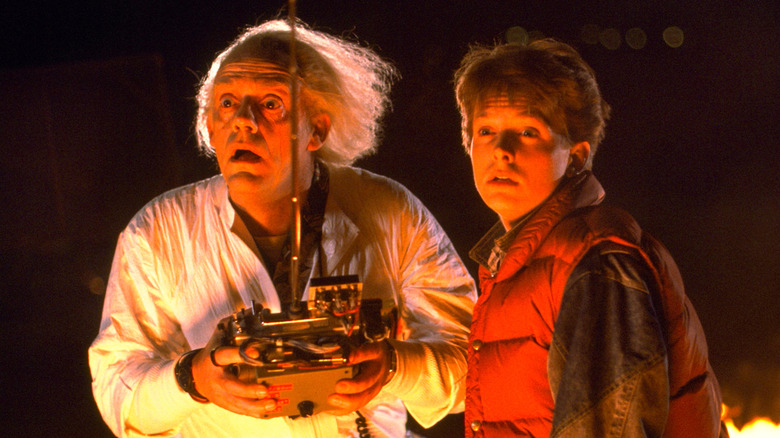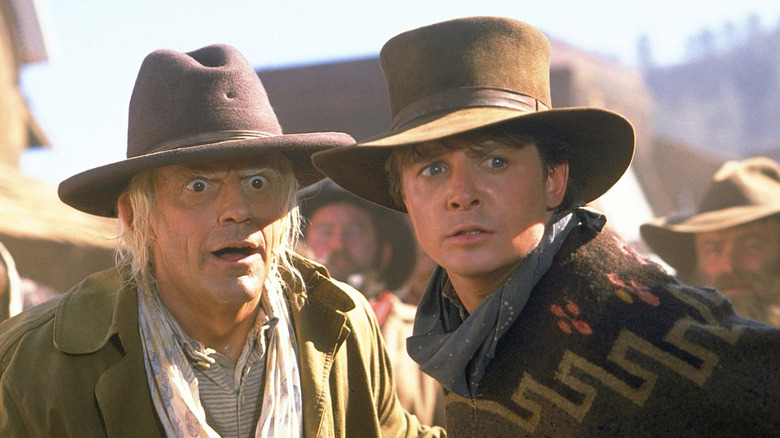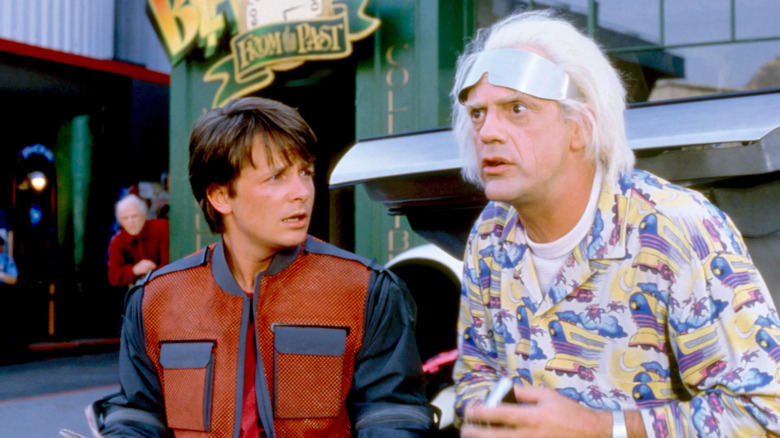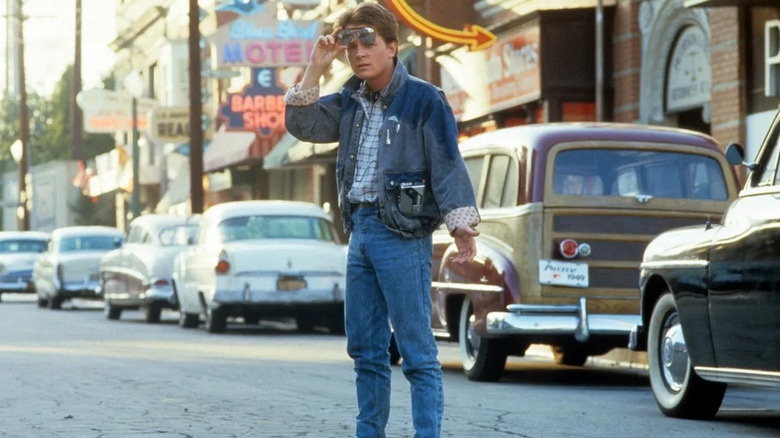The Back To The Future Movies Ranked
The concept of time travel, though usually lumped in with science fiction, is actually far closer to fantasy. The notion is rooted in nostalgia, the collective unconscious assumption that there was such a thing as "the good old days." It's also borne out of an interest in history, which as "The Holdovers" so recently and succinctly stated, is really an interest in knowing more about ourselves. While actual time travel will likely never exist (for paradoxical reasons, if nothing else), a particular form of it has already existed for over 100 years: cinema.
If poring through film history allows a viewer to ostensibly travel through time, then it only follows that cinema would be a natural tool to examine history and time travel as well. When co-writer and producer Bob Gale hit upon his father's old high school yearbook one day and wondered if he and his father would've been friends (let alone like each other) had they been the same age at the same time, he quickly realized that a movie would be the best way to explore this concept. Co-writer and director, Robert Zemeckis, had already begun a filmmaking career taking a look at America's own unique form of nostalgia (that is inexorably wrapped up with self-mythologizing), a trend that carries through his films from "I Wanna Hold Your Hand" to "Forrest Gump." Thus, "Back to the Future" was born.
Any interview with Zemeckis and Gale would tell you that neither man intended "Back to the Future" to have a sequel, let alone become a trilogy. Yet not only did the concept of time travel and the winning ensemble of characters they created lend itself to further adventures, but the possibilities of experimenting with genre and form proved too enticing to turn down. Here, then, is the "Back to the Future" trilogy ranked from "pretty great" to "masterpiece," the three films (no more, no less) providing an exciting and hilarious look at America's past, present, and future.
3. Back to the Future Part III (1990)
Both of the "Back to the Future" sequels are mildly controversial (at least when it comes to rankings) solely for the big swing each film takes. For "Part III," it's the way the trilogy comes to a close with a fully-fledged Western pastiche. The bulk of the movie takes place in Hill Valley, 1885, just as the town is being born and Emmett "Doc" Brown (Christopher Lloyd), a refugee in the past after the events of "Part II," is seemingly destined to be shot by "Mad Dog" Tannen (Thomas F. Wilson) after meeting the time-crossed love of his life, school teacher Clara Clayton (Mary Steenburgen). Where "Part II" escalated the space-time continuum shenanigans of the first film, "Part III" can tend to feel a little subdued, the Western trappings almost seeming like a temporary detour from the larger story. Additionally, unlike the first two films, the installment is much more Doc's movie than Marty McFly's (Michael J. Fox).
In context and with the benefit of hindsight, however, "Part III" does the right thing in making Doc a fully-fledged character (as opposed to Marty's quicky sidekick-cum-mentor who's relegated mostly to exposition), allowing the trilogy to feel more like it's about all of Hill Valley and not just the McFly's. That focus blends nicely with the larger subtext of "Part III," examining how so many generational and historical issues were born right along with the town (and, by extension, the country), reiterating more broadly the moral lessons of the original film: so much can be changed for the better if bullies are stood up to, all while learning not to give into your most foolish impulses and faults yourself.
Put simply, "Back to the Future Part III" is a consummate example of a big Hollywood adventure: the set pieces are thrilling, Alan Silvestri's score is as rousing as anything Elmer Bernstein ever did, Lloyd makes for an offbeat romantic hero, and Fox rounds out Marty McFly, proving him to be a character with a future that can be anything that he wishes to make it.
2. Back to the Future Part II (1989)
For both Zemeckis and Gale as well as Marty and Doc, "Back to the Future II" begins with a problem: how to solve the ending of "Back to the Future." Originally intended as a joke about generational issues, the ending — in which Marty, Doc, and Marty's girlfriend, Jennifer (Elisabeth Shue), fly in a time-traveling DeLorean to 2015 to fix Marty and Jennifer's kids — became a bit of a burden. After an entire draft was written in which the sequel would more or less reprise the first film, with Marty and Doc in the 1960s nearly interrupting the former's conception, Zemeckis hit upon an idea of not just reprising the first movie, but literally replaying it.
Thus, "Part II" ends up as one of the most ingenious sequels ever made, the conceit of time travel allowing the movie to re-use and integrate footage from the first film as a way of giving audiences the Platonic sequel experience of "the same, but different." For some, this idea may feel too lazy or obvious, while for others, the notion of a stolen Sports Almanac from 2015 allowing Biff Tannen to create an alternate 1985 where he's married to Lorraine McFly (Lea Thompson) and essentially owns Hill Valley may be too confusing, even with Doc's helpful chalkboard timeline illustrations.
For the rest of us along for the ride, however, "Part II" is a veritable feast of futurism jokes (some of which came true; looking at you, "Cafe '80s"), generational farce (featuring Fox running into himself while playing other timeline versions of Marty as well as playing other McFly family members), and a poignant riff on "It's a Wonderful Life," with Tannen's Hill Valley becoming this film's Pottersville (not to mention doubling as a knowing and disturbingly prescient riff on the exploits of one Donald J. Trump). In combining smart and silly so effortlessly, "Back to the Future Part II," like Marty says upon finding the Almanac, "can't lose."
1. Back to the Future (1985)
In everyone's life, there are fundamental questions we ask ourselves at one point or another. "What if I could honestly be friends with my parents?" "What if my parents thought I was actually attractive, and they weren't just saying that?" "What if you made a time machine ... out of a DeLorean?"
Alright, you got me: they're not actually such average, normal questions. The big, unspoken secret of "Back to the Future" lies in the way it subverts the time travel subgenre, not only by introducing such wacky concepts but by combining science fiction with the then-rising teen movie trend, poking fun at both while expanding them beyond the confines of their respective genres. As the end product of a run of teen-oriented "maybe it wasn't all sunshine and roses" look-back films that had begun with "American Graffiti," Zemeckis and Gale use the movie to interrogate the 1980s' relationship with the repressive, falsely idyllic 1950s, poking holes in Mr. and Mrs. McFly's self-mythologizing "back in my day" tales by showing Marty and us what they were really like. All the while, the filmmakers use Marty's rags-to-riches journey as a sly commentary on the present day, demonstrating how much the American value system had changed thanks to, as Doc scoffs, the actor-turned-unlikely-President, Ronald Reagan.
All that subtext aside, "Back to the Future" is a rollicking comedy-adventure film, following Marty through an increasing series of obstacles and mishaps as he valiantly tries to put things back where they're supposed to be, if not ought to be. Now that the film is nearly 40 years old, it's entered into a unique space in pop culture: a still-relevant movie that is both an eternal parable and a preserved time capsule. While that special mix of nostalgia and escapist futurism keeps the brand alive (with the help of a hit stage musical but without the benefit of a lazy remake or reboot, something Zemeckis, Gale, and even Fox refuse to indulge in), the lasting power of "Back to the Future" lies in its romantic core. Whether it's the affection between Marty and Jennifer, Doc and Clara, or Marty and Doc, "Back to the Future" endures because, as Huey Lewis and the News succinctly put it: that's the power of love.



